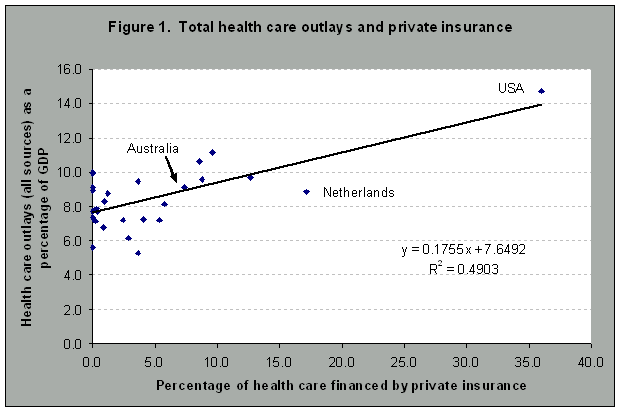Paying for health careShould we pay for health care through collective insurance or from our own pockets? Like most questions in public policy, there is no simple answer. Those who argue for collective insurance generally do so on the basis of equity. Poor health is correlated with poor means and ageing, and health care needs usually strike unexpectedly; we cannot budget for our health care outlays. Furthermore, many people argue that health care is a ‘solidarity good’; it is one of the services citizens choose to share as part of our mutual obligation to one another. Those who argue for out-of-pocket payments point to the efficiency of markets in controlling prices and allocating resources, and warn that ‘free’ services competing with charged services (such as allied health care services) and lifestyle choices (diet and exercise) lead to over-use of expensive health care resources. While acknowledging that there are ‘market failures’ in health care, they tend to urge more use of price signals anyway. Both views are economically defensible, and most societies come to a compromise between these objectives, with some mixture of collective public insurance and uninsured out-of-pocket outlays. What is not economically defensible, however, is to allow, or worse (as in Australia’s case) to support, private insurance as a means of funding health care. Private insurance is the worst-of-all-worlds solution, for it muzzles market signals, while it lacks the market power enjoyed by single national insurers. When services are free, or heavily subsidised at point of service, there is over-use; the idea that ‘Medicare will pay for it’ is no different from the idea that ‘MBF/HCF/Medibank Private will pay for it.’ And while a single national insurer can control price and utilization, private insurers are weak in the market because service providers play them off against one another. In addition, because they must market their services, their administrative overheads are high. Another emerging cost impost is the need to pay returns to shareholders, as the former mutual firms head down the path of de-mutualization. It would be reasonable, therefore, to predict that private insurance contributes to high health care costs.
That prediction is borne out by the evidence. Figure 1, drawn from OECD data for 2002 (the latest for which a reasonably complete set of international data is available), shows health care outlays as a percentage of GDP (on the vertical axis), against the percentage of health care funding passing through private insurance (on the horizontal axis). The relationship is strong. Private insurance leads to high health care costs. It could be suggested that private insurance, while expensive, buys better health care, and that the upward slope is no more than an indicator of this relationship. This explanation is fatuous on a national level. Individuals with private insurance may be able to jump the queue or buy privileged access to scarce resources, but on a national basis there is no net benefit. All OECD countries, particularly the ‘earlier’ members, have reasonably good health care outcomes. To the extent that there is variation in national health outcomes, it tends to reflect national income differences and, in particular, differences in poverty and inequality, which is why health outcomes in the USA are poorer than those of many other prosperous countries. In this analysis the USA stands out, with health care costing 14.7 percent of GDP (it rose to 15.3 percent in 2004). Just as European countries pioneered universal national insurance, the USA led the way in private insurance (employer-funded insurance emerged during the 1941-45 war as a means of evading wage controls). The USA is now counting the cost, with at least 40 million unemployed, casually employed, and self-employed left uninsured. Furthermore, the burden of insurance premiums adds to employers’ labour costs, to the detriment of international competitiveness. Even the USA has to have a safety net of government programs – Medicare for the aged, and Medicaid (a pared-down parsimonious program) for the ‘indigent’. Because these limited programs operate in a market where prices are elevated by private insurance, they are imposing a heavy burden on public budgets. These programs cost US governments 6.9 percent of GDP, which is more than the UK spends for its comprehensive National Health Service (budgetary outlays of 6.4 percent of GDP) and only a little less than is spent by the Scandinavians for their very high quality universal health care schemes. The countries with universal government-provided health insurance, such as Britain and the Scandinavian countries, are all down the left hand side of the graph. They achieve good health care at a reasonable cost. In these countries not all services are free. In Sweden, Norway and Iceland, for example, there are reasonably high patient co-payments. But their common characteristic is an absence of private health insurance. Some readers may notice that the Netherlands stands out on the graph, with a high level of private health insurance, but with expenditure below the trend line. But the Netherlands has only recently moved to extend the reach of private insurance; it’s highly probable that the Netherlands will catch up with those countries where private insurance is more entrenched. Here, in Australia, we should learn from international experience. We need to remove private insurance from health care funding, and entrench Medicare as a truly universal insurer. That is not to say we should remove the private sector. The private sector has a legitimate and valuable role in providing health care, but we do not need it in the funding mix. After all, private insurance is simply a poor substitute for the tax and Medicare systems for gathering and distributing funds, and it does so at much higher cost and with much less equity. Nor is it to say that our universal system should be a ‘free’ system. The division between free and paid services at present is messy and inconsistent. It almost certainly distorts resource allocation away from some low-cost services to high-cost medical interventions.
To achieve better public policy we need two changes in government thinking. One is to remove the ideology of hostility to the public sector – an ideology that makes no more economic sense than the old Soviet hostility to the private sector. The other is to start thinking not just about budgetary outlays (as is done in documents such as the Intergenerational Report), but about the community’s total outlays on health care. In essence that means shifting from a narrow financial focus and towards a broader economic responsibility. Is the present government capable of such a shift? Perhaps it has forgotten, if it ever knew, about the difference between financial management (attending to government budgets) and economic management (attending to community interests). Source dataHealth expenditure 2002
|

